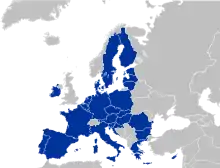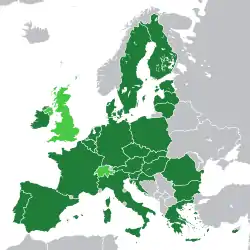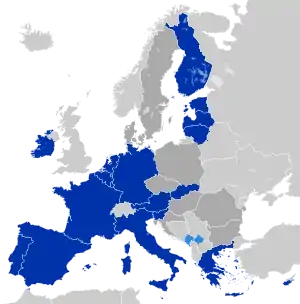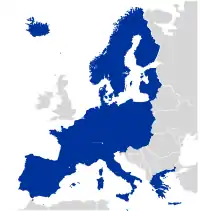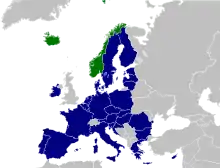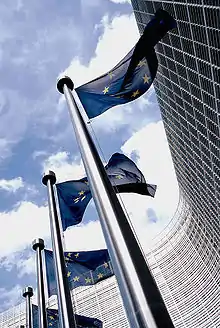Scientific Advice Mechanism
The Scientific Advice Mechanism is a service created by the European Commission which provides independent science advice directly to European Commissioners to inform their decision-making.[1] The Mechanism consists of two parts: the Group of Chief Scientific Advisors, an expert group consisting of up to seven leading scientists,[2] and SAPEA, a consortium of five European Academy Networks collectively representing around 100 academies and learned societies across Europe.[3]
 |
|---|
| This article is part of a series on the politics and government of the European Union |
|
|
History
Until 2016, science advice in the European Commission was provided by a single Chief Scientific Advisor who reported directly to the President of the European Commission. The last Chief Scientific Advisor, serving from 2012 to 2014, was Dame Anne Glover.
On 1 November 2014, European Commission President Jean-Claude Juncker asked Carlos Moedas, Commissioner for Research, Innovation and Science in his mission letter to "make sure that Commission proposals and activities are based on sound scientific evidence and contribute best to our jobs and growth agenda".[4] Following this, on 13 May 2015, Juncker announced the establishment of the Scientific Advice Mechanism. The first seven members of the Advisors were identified, following a European call for nominations, in January 2016.
In December 2016, SAPEA was officially launched to support the Advisors by providing scientific evidence review reports.
Structure
Group of Chief Scientific Advisors
The core of the Scientific Advice Mechanism is the European Commission's Group of Chief Scientific Advisors, an expert group consisting of up to seven leading scientists, selected by the European Commission assisted by an independent identification committee. The Advisors are supported by a dedicated secretariat, known as the SAM Unit, staffed by the Directorate-General for Research and Innovation and Joint Research Centre.
The Group of Chief Scientific Advisors currently consists of the following seven members:
| Name | Portrait | Role in the Group | Academic position | University or institution |
|---|---|---|---|---|
| Nicole Grobert[5] |  |
Chair | Professor of Nanomaterials | University of Oxford |
| Carina Keskitalo[6] | .jpg.webp) |
Professor of Political Science | Umeå University | |
| Éva Kondorosi[7] |  |
Research Director | Institute of Plant Biology, Biological Research Centre (Hungarian Academy of Sciences) | |
| Maarja Kruusmaa[8] |  |
Vice-rector for research and Professor of biorobotics | Tallinn University of Technology | |
| Alberto Melloni[9] |  |
Professor of the history of Christianity; holder of the UNESCO Chair on Religious Pluralism and Peace | University of Modena/Reggio Emilia; University of Bologna | |
| Nebojsa Nakicenovic[10] |  |
Director | The World In 2050 | |
| Paul Nurse[11] | .jpg.webp) |
Deputy chair | Director | Francis Crick Institute |
Previous members of the Group of Chief Scientific Advisors include:
- Julia Slingo (2015–2016)
- Henrik Wegener (2015–2017)
- Cédric Villani (2015–2017)
- Janusz Bujnicki (2015–2020)
- Pearl Dykstra (2015-2020)
- Rolf-Dieter Heuer (2015-2020)
Science Advice for Policy by European Academies (SAPEA)
SAPEA brings together more than 100 academies, young academies and learned societies. Its role as part of the Scientific Advice Mechanism is to provide high-quality, independent evidence to underpin the Scientific Opinions produced by the Chief Scientific Advisors. SAPEA has the ability to convene Fellows from some 40 countries across Europe, spanning the disciplines of engineering, humanities, medicine, natural sciences and social sciences.
The SAPEA consortium brings together five umbrella networks jointly representing Europe's academies:
- Academia Europaea[12]
- All European Academies[13]
- European Academies' Science Advisory Council[14]
- European Council of Applied Sciences and Engineering[15]
- Federation of European Academies of Medicine[16]
At present, SAPEA is funded by a grant from the European Union's Horizon 2020 programme through to the end of 2021.[17]
Scientific advice
The Scientific Advice Mechanism has issued advice in the form of Scientific Opinions, explanatory notes or statements, supported by evidence review reports, on the following topics:
| Topic | Date | Advisors' advice | SAPEA evidence review |
|---|---|---|---|
| Glyphosate | June 2016 | none | |
| Light-duty vehicle real-drive CO2 emissions | November 2016 | none | |
| Cyber-security in the European Digital Single Market | March 2017 | none | |
| New techniques in agricultural biotechnology | April 2017 | none | |
| Food from the oceans | November 2017 | ||
| Novel carbon capture and utilisation technologies: research and climate aspects | May 2018 | ||
| Authorisation processes of plant protection products in Europe | June 2018 | ||
| Statement on the regulation of gene editing | November 2018 | none | |
| A scientific perspective on microplastics in nature and society | January 2019 | ||
| Transforming the future of ageing | July 2019 | ||
| Making sense of science for policy under conditions of complexity and uncertainty | July 2019 | ||
| Towards a sustainable food system for Europe | April 2020 | ||
| Adaptation to climate change-related health effects | June 2020 | none | |
| COVID-19, future pandemics and other crises in the global context (with European Group on Ethics in Science and New Technologies) | November 2020 | none | |
| Biodegradability of plastics in the open environment | December 2020 | ||
| A systemic approach to the energy transition in Europe | Spring 2021 |
References
- "About the Scientific Advice Mechanism | SAM – Research and Innovation – European Commission". ec.europa.eu. Retrieved 28 March 2019.
- "Group of Chief Scientific Advisors | SAM – Research and Innovation – European Commission". ec.europa.eu. Retrieved 28 March 2019.
- "About us | SAPEA". www.sapea.info. Retrieved 28 March 2019.
- Juncker, Jean-Claude (1 November 2014). "Mission letter to Commissioner Moedas" (PDF). European Commission.
- "Group of Chief Scientific Advisors | SAM – Research and Innovation – European Commission". ec.europa.eu. Retrieved 28 March 2019.
- "Group of Chief Scientific Advisors | SAM – Research and Innovation – European Commission". ec.europa.eu. Retrieved 18 November 2020.
- "Group of Chief Scientific Advisors | SAM – Research and Innovation – European Commission". ec.europa.eu. Retrieved 18 November 2020.
- "Group of Chief Scientific Advisors | SAM – Research and Innovation – European Commission". ec.europa.eu. Retrieved 18 November 2020.
- "Group of Chief Scientific Advisors | SAM – Research and Innovation – European Commission". ec.europa.eu. Retrieved 18 November 2020.
- "Group of Chief Scientific Advisors | SAM – Research and Innovation – European Commission". ec.europa.eu. Retrieved 18 November 2020.
- "Group of Chief Scientific Advisors | SAM – Research and Innovation – European Commission". ec.europa.eu. Retrieved 28 March 2019.
- "Academy of Europe: SAPEA". www.ae-info.org. Retrieved 28 March 2019.
- "SAPEA: Science Advice for Policy by European Academies -". Retrieved 28 March 2019.
- "SAPEA". EASAC Website. 25 January 2018. Retrieved 28 March 2019.
- "SAM: Scientific Advice Mechanism". www.euro-case.org. Retrieved 28 March 2019.
- "SAPEA | FEAM". www.feam.eu. Retrieved 28 March 2019.
- "Cordis project database". cordis.europa.eu. Retrieved 14 April 2020.
